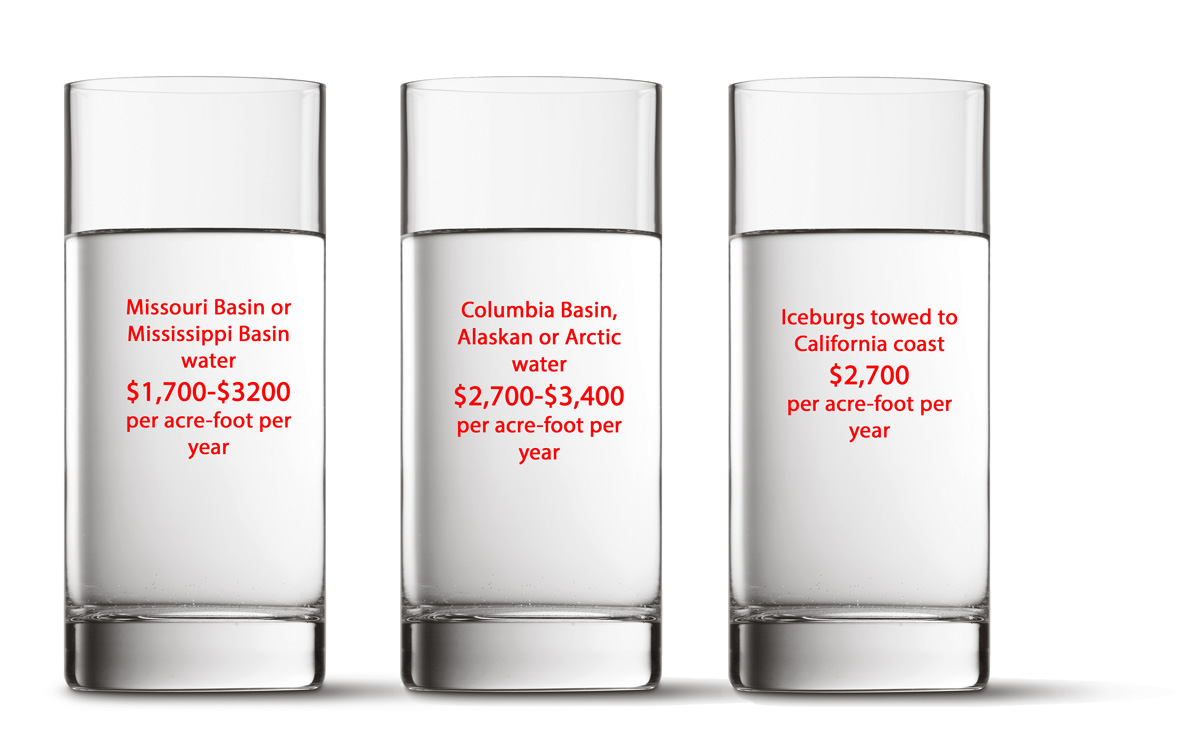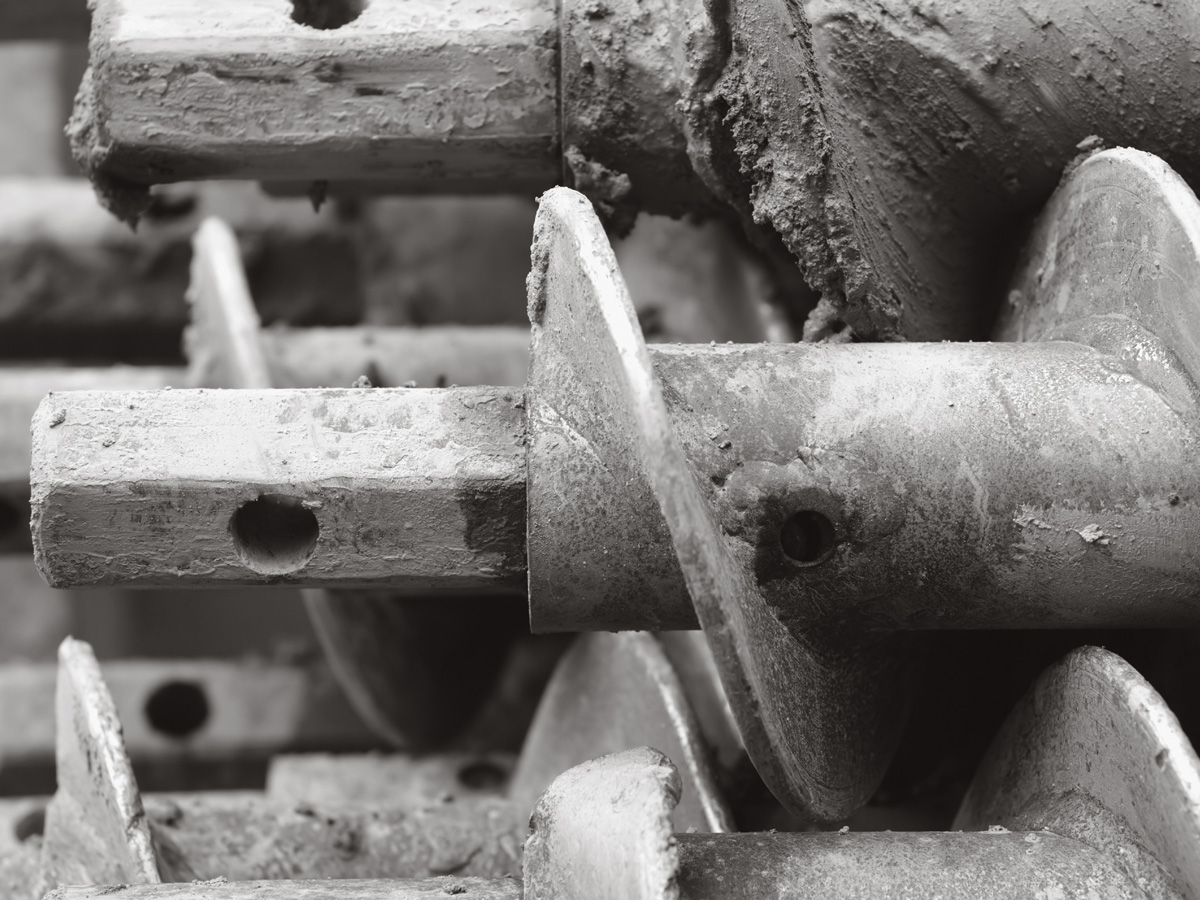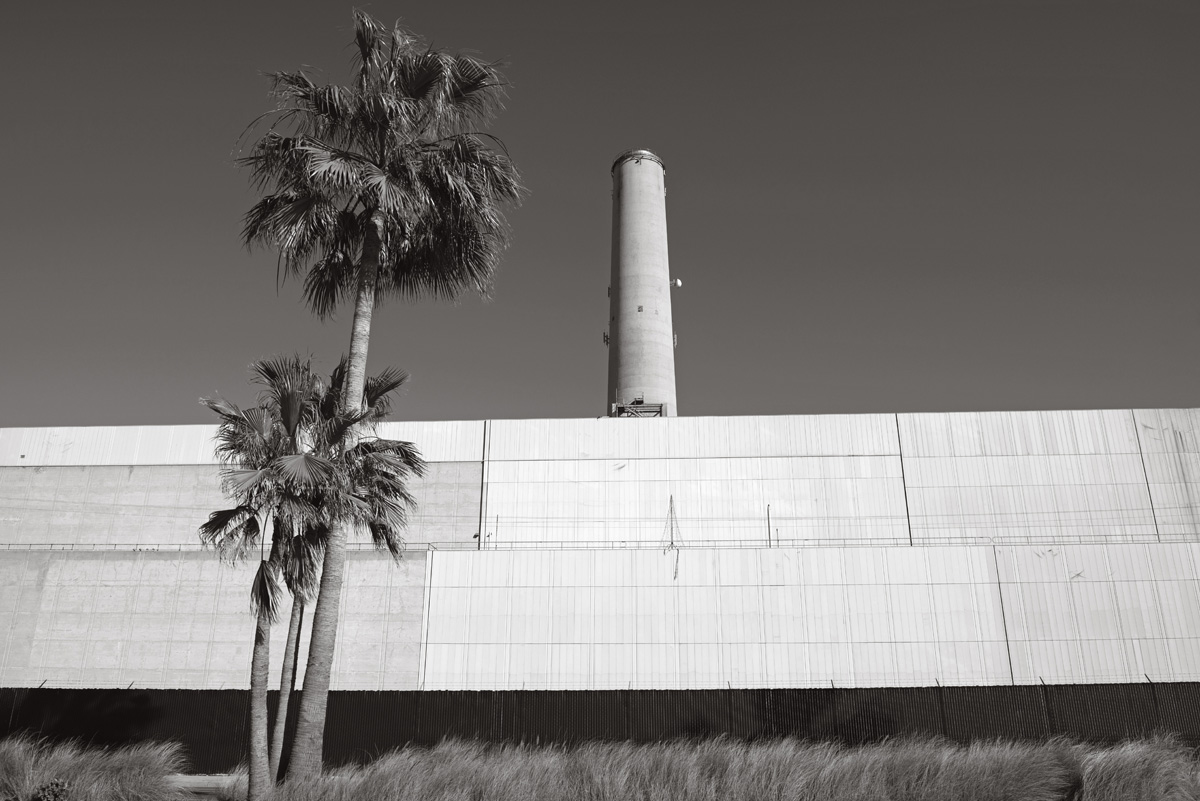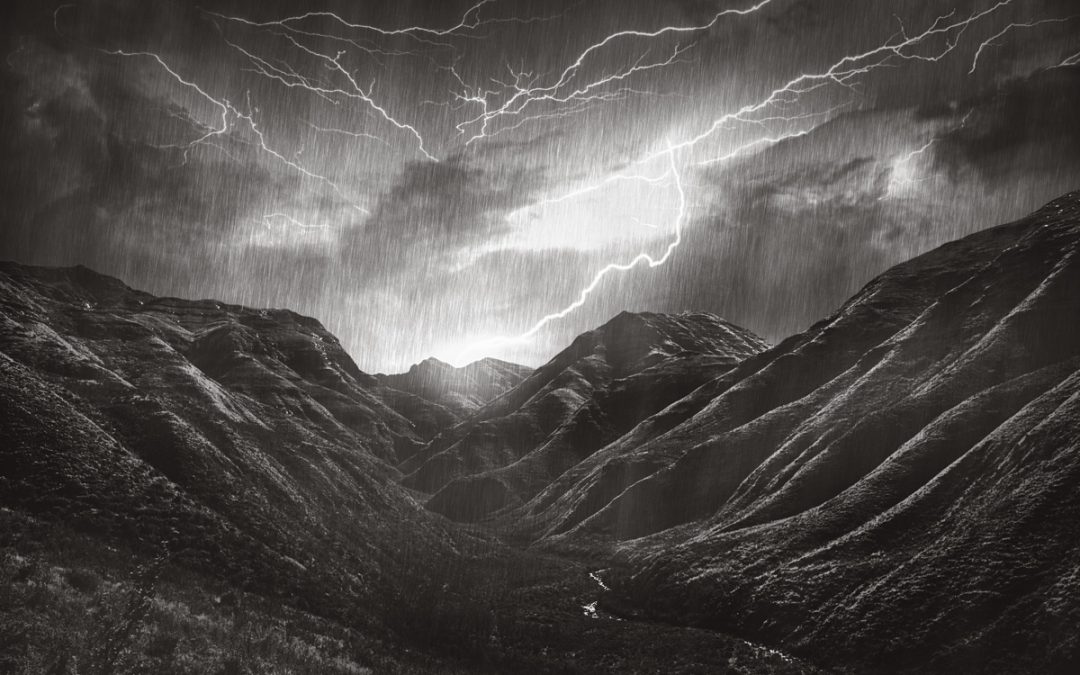It flows, but does it hold water?
To make conventional wisdom, take a grain of truth, lard it with a few misconceptions and throw in a preconceived notion or two. The result is the kind of simplistic belief that abounds in discussions of the Colorado River Basin, undergirding the idea that there is a silver-bullet solution for our water supply woes, that simply tearing up lawns, outlasting drought or building a pipeline will resolve our water problems. These notions, while easily bandied about at the dinner table, are hardly strong enough to inform a water policy, and close examination proves them false, or at least incomplete. With that in mind, we’ve set out to debunk six common myths about the Colorado River. Flowing through all of them is the most insidious myth of all: that the looming water shortages have any single cause, or any single solution.
Myth #1: We can shrug off the impacts to agriculture as municipalities work to acquire the water they need.
More than 70 percent: That’s how much of the Colorado River agriculture requires every year, making the sector an easy target for cities seeking to slake the thirst of growing populations. Yet if the “buy and dry” of agricultural land intensifies in the face of drought and growth, could it jeopardize food security?
According to a 2013 study by the Pacific Institute, a water policy nonprofit, about 15 percent of the nation’s food is grown with Colorado River water. Irrigated pasture, alfalfa and other feed for livestock occupy 60 percent of the basin’s agricultural acreage, while a smaller fraction—around 8 percent—is used to grow vegetables in places like California’s Imperial Valley and Coachella Valley and Yuma, Arizona. Those vegetables fill an important niche, accounting for up to two-thirds of the produce on grocery store shelves every winter, according to the Imperial County Farm Bureau.
If buy and dry continues in the basin, the crops likely to be hit first are lower-value items like pasture and alfalfa, according to Michael Cohen, lead author of the Pacific Institute report.
“Winter vegetables are revenue earners, and they provide the bulk of annual revenue for many farmers,” Cohen says, “so we are not likely to see declines in vegetable acreage right away.” Instead, farmers who grow lower-value crops like feed for cattle could be the first to sell out to urban water providers, prompting a drop in U.S. forage crop exports, a rise in meat and milk prices for U.S. consumers, and perhaps even the shakeup of local economies in regions like Colorado’s Weld County as dairies and feedlots relocate to stay close to affordable feed sources.
Yet paying more for milk may not be inevitable to balance water supply and demand in the basin. In fact, agriculture’s current water usage is so vast that some say modest declines—reducing use by 10 percent through steps like deficit irrigation, rotational fallowing and crop selection—could rebalance the basin’s water budget.
“The food security discussion often is framed as either keeping the status quo in place or eliminating agriculture entirely and running out of local food,” says Doug Kenney, director of the Western Water Policy Program at the University of Colorado, Boulder. “But no one is really talking about drying up all of agriculture.”
Myth #2: Sufficient reduction in municipal use could solve the imbalances on the Colorado River.
The notion that simply drying up urban lawns and installing water efficient fixtures from Denver to Los Angeles could, on its own, alleviate the water supply gap on the Colorado River ignores a fundamental fact. The municipal and industrial sectors use only about 15 percent of the river’s water, so they lack the leverage to single-handedly rebalance the river’s water budget.
“Most people agree that the gap can’t be fully filled by municipal conservation alone,” says Aaron Citron, a member of the Colorado River Project at the Environmental Defense Fund. “Agriculture will need to play a part.”
Examining the size of the river’s projected water gap makes plain that addressing it will require aggressive conservation in every economic sphere.
By 2060, according to a 2012 study by the U.S. Bureau of Reclamation, demand will likely significantly outstrip supply: Modeling suggests that climate change could reduce the river’s average flow by as much as 9 percent from current levels (many models predict greater declines), even as growing urban centers drive water demand up, yielding a median long-term water supply deficit of 3.2 million acre-feet by 2060.
Although cities won’t be able to close that yawning gap on their own, municipal conservation can free up significant water to support population growth. Denver Water customers collectively consume 5 percent less water now than in 1990, even though the utility’s customer base has grown by 30 percent. California’s largest water provider, the Metropolitan Water District of Southern California, saw its service area grow by 3.5 million people between 1990 and 2008, even as water use dropped by more than 4 percent. And Las Vegas has grown by about 25 percent since the year 2000, at the same time cutting water use by 33 percent.

Myth #3: We can import solutions (in liquid form) from another river basin.
The 40 million people who depend on the Colorado River often demand more water than it can provide, so what’s to stop them from meeting their needs with water from another river basin, in the same way that cities like Denver and Los Angeles import water from the Colorado River itself?
Setting aside philosophical arguments about whether basin residents should live within their hydrological means (and the fervent opposition of people in other basins whose water is targeted) the chief obstacle to options like piping in water from the Mississippi, Missouri or Columbia rivers—or even using tug boats to tow icebergs from the Arctic to southern California—is their astronomical cost.
The Bureau of Reclamation’s 2012 Colorado River Basin Water Supply and Demand Study examined several water importation options and estimated their likely price tag at between $1,700 and $2,300 per acre-foot per year for water piped from the Missouri or Mississippi rivers, and between $2,700 and $3,400 per acre-foot for water imported from the Columbia River, Alaska or the Arctic via pipelines or tanker ships. Such options could take 15 to 30 years to implement, the study estimated, due to their complexity and dependence on contentious negotiations. Conserving water that’s already in the basin would cost less than half as much and could be deployed more quickly.
Still, some, including the Colorado Water Conservation Board and its pending final draft of Colorado’s Water Plan, question whether conservation alone can fill the water supply gap in Colorado and throughout the basin.
John Kaufman, the general manager of the Centennial Water and Sanitation District that serves Colorado’s Highlands Ranch community south of Denver, is among these skeptics and a strong proponent of a pipeline that would bring water from the Missouri River near Leavenworth, Kansas, to Colorado’s Front Range, helping to replenish the declining Ogallala Aquifer along the way.
Kaufman speaks on his own behalf when he advocates for the pipeline. As evidence of its potential, he cites a 2015 study by the U.S. Army Corps of Engineers that examined the feasibility of building an aqueduct from the Missouri River to western Kansas. The study found that between 900,000 and 3.2 million acre-feet could be moved westward at least 50 percent of the time without harming water users on the Missouri River. How much of that would wind up in Colorado is unclear, though Kaufman contends that a half million acre-feet per year would remain after Kansas’ thirst is quenched. He suggests that the aqueduct’s cost—estimated by the Army Corps to be more than $18 billion—could be shared among water users in Kansas, Colorado, and even states like California, Nevada and Arizona, since a reduction in eastern Colorado’s demand for Colorado River water could free up more for downstream states to use.
Myth #4: We’ll be fine once things get back to normal and the drought ends.
In the 15 years since the current drought began, the flow of the Colorado River at Lee Ferry in northern Arizona has declined by a whopping 17 percent. If only precipitation levels returned to normal, the river’s flow would follow, right?
Wrong, says Brad Udall, senior water and climate research scientist at the Colorado Water Institute at Colorado State University. In fact, precipitation in the Colorado River Basin between 2000 and 2010 was down just 4 percent from its historic average, according to the federally funded Southwest Regional Climate Assessment published in 2013. What’s driving the decline in runoff more strongly, Udall suspects, is a basin-wide rise in average temperature linked to climate change.
In a 2014 analysis of 16 hydrological models published in the Bulletin of the American Metrological Society, Udall and other researchers established a strong relationship between precipitation and runoff: Cut rain and snow by 1 percent and runoff declines by 2 or 3 percent. Yet the link between temperature and runoff goes even further in explaining why climate change will prevent flows in the Colorado River from returning to “normal” anytime soon.
The 2014 study suggested that for every 1 degree Fahrenheit rise in temperature, runoff declines by about 3.5 percent. That’s partly because plants grow faster and lose more water to evapotranspiration in warmer climes, sucking up more water as a result. If greenhouse gas emissions stay high, much more warming—as much as 6.5 degrees Fahrenheit compared to the 1971-2000 baseline—is expected by 2050, and the study suggests that could reduce runoff by more than 20 percent. Some warming is already “baked in” to our atmosphere by greenhouse gases emitted in the past and will occur even if we move entirely away from fossil fuels tomorrow. Add the effect of declining precipitation in the event of continued drought, and it’s easy to see that the flow of the Colorado River could drop by as much as a quarter by mid-century, even as population in the basin booms.
The takeaway, says Udall, is that regardless of whether the drought persists, climate change has already transformed the flow of the Colorado River: “Heat drives the water cycle, and if you add extra heat, you should expect the water cycle to change.”

Myth #5: Groundwater will be our salvation.
Imagine an underground reservoir containing 13 billion gallons of water—even more than the capacity of Lake Mead behind Hoover Dam. As drought seized the Colorado River Basin between 2000 and 2013, that’s how much groundwater users pumped from aquifers to compensate for declines in surface water supplies, according to a 2014 study in the peer-reviewed journal Geophysical Research Letters.
The study used NASA satellites to measure changes in the Earth’s gravitational pull, which indicate variations in the amount of water present on Earth. They then attempted to isolate the fraction of water present as snow, surface water, soil moisture and groundwater, and then subtracted those first three from the total to determine groundwater loss. Some researchers, including Brad Udall at the Colorado Water Institute, question the precision of this approach, because uncertainty about the amount of water contained in snow or soil could throw off the groundwater loss calculation. Still, even Udall acknowledges that widespread over-pumping of groundwater has occurred during the recent drought. That over-pumping has been spurred by a poor understanding of groundwater reserves, lax regulation, and other factors, and it raises doubts about whether groundwater will be available to dampen the impact of future droughts.
“I think the point that gets lost on many people is that we cannot rely on groundwater if this drought continues,” says Stephanie Castle, who led the team behind the 2014 study as a doctoral student at University of California, Irvine and is now a water resources specialist for the southern California firm Fuscoe Engineering.
As Castle points out, groundwater pumping helps mask the fact that demand for surface water in the Colorado River Basin already regularly exceeds supply. If groundwater levels decline sharply—as her study showed they already have—it will place additional pressure on already stretched surface water supplies.
“In California we depend on groundwater for about 40 percent of our water supply in a normal year,” she says, “but during drought it’s more like 60 percent. What if we get into the next drought and that 60 percent isn’t there?”
Due to a combination of factors, that scenario looks increasingly likely. For one, California didn’t regulate groundwater withdrawals on a statewide basis until 2014, and the Sustainable Groundwater Management Act passed that year doesn’t require local jurisdictions to reach sustainable groundwater pumping levels until the 2040s. For now, officials in many historically unregulated California groundwater basins lack either a clear understanding of how much water remains or the means to preserve it through regulation.
The over-pumping that’s occurred in this regulatory vacuum has already caused wells to dry up in parts of California and Arizona, where groundwater is regulated as though it were separate from surface water. In parts of California’s agriculturally rich Central Valley, the ground has subsided by 30 feet as the water below disappears. Such subsidence can lead to permanent declines in the capacity of aquifers, as they compact and become incapable of holding the water they once did.
“People are already running out [of groundwater] in some places,” says Castle, “and that’s really scary to me.”

Myth #6: The coastal areas of the lower basin can tap the vast ocean and desalinate their way into supply, leaving enough water for the rest of us.
It’s not that desalination is pie-in-the-sky technology. Of the thousands of plants now operating across the globe, most filter brackish groundwater but some treat seawater as well. Israel will soon get half of its water from desalination. California, too, is looking afresh at the technology as it battles its worst drought in 500 years. Sean Bothwell, an attorney for the California Coastkeeper Alliance who helped shape the statewide desalination plan released by California regulators in 2015, estimates that at least 15 to 17 desalination plants are now planned across the state, including one scheduled to open in San Diego in late 2015.
Widespread desalination on the California coast is often envisioned as a way of reducing California’s demand for Colorado River water and perhaps even allowing the state to sell some of its water rights on the river to upstream users. Yet two factors—opposition from California utilities and the sheer size of southern California’s water demand—make that solution unlikely to materialize, according to Bothwell.
“Southern California’s water demand is just too large to be offset by desalination, and agencies are not willing to pay for desalination to end Colorado River diversions,” he says. The Metropolitan Water District of Southern California, the region’s largest water utility, in 2009 offered subsidies for the San Diego desalination plant, but it did so specifically on the condition that the plant’s output not replace Metropolitan’s imported water—and later rescinded the offer for other reasons. Theoretically, the plant could still allow other local providers to import less water.
Even if it takes pressure off the overtaxed Colorado, desalination can come with a dark side. Open-ocean water intakes like the ones featured in the new San Diego plant kill fish larvae and other marine life, while the salty brine left over from desalination can damage seafloor habitat if discharged without being diluted first.
California’s desalination plan addresses these impacts by requiring less damaging intakes be installed in newer plants and recommending that brine be diluted with treated wastewater prior to release. What it doesn’t address is the fact that desalination, which forces water through membranes small enough to separate dissolved salt, requires vast amounts of energy. A 2013 Pacific Institute study found that generating a million gallons of desalinated water takes as much as 15,000 kilowatt-hours (kWh) of electricity—nearly 1.5 times the annual use of the average American home—compared to the 8,300 kWh needed to generate that same volume of water through wastewater reuse. Energy is the largest single expense for desalination plant operators, leaving them vulnerable to rising power costs. And generating all that energy contributes to climate change, which has already led to declines in the flow of the Colorado River.
The high infrastructure and energy costs of desalination also raise the possibility that plants built today may be too costly to operate in the future, if the drought lifts or cheaper water supplies—like those generated through conservation—become available. That’s what happened in Australia, where four of the six large desalination plants the country built starting in the mid-1990s now stand idle, rendered prohibitively expensive by an easing drought and strong nationwide efficiency measures. Customers are still paying the plants off through surcharges on their water bills, and while the facilities add redundancy to existing water sources, they’re not contributing a drop to the nation’s water supply.


 Print
Print